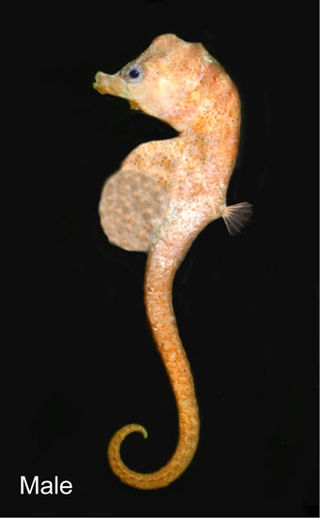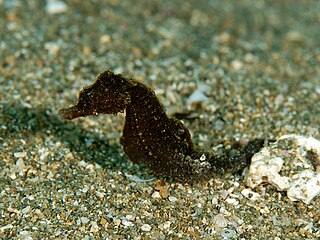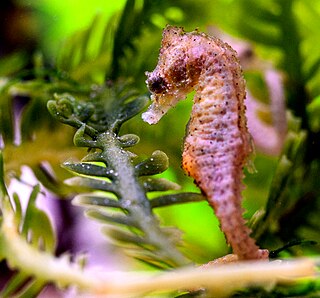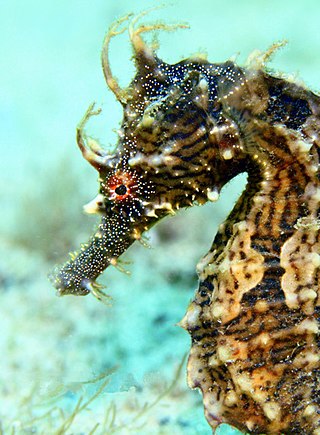
A seahorse is any of 46 species of small marine bony fish in the genus Hippocampus. "Hippocampus" comes from the Ancient Greek hippókampos (ἱππόκαμπος), itself from híppos (ἵππος) meaning "horse" and kámpos (κάμπος) meaning "sea monster" or "sea animal". Having a head and neck suggestive of a horse, seahorses also feature segmented bony armour, an upright posture and a curled prehensile tail. Along with the pipefishes and seadragons they form the family Syngnathidae.

The quagga catshark is a species of shark belonging to the family Pentanchidae, the deepwater catsharks. A small, slim-bodied shark reaching 37 cm (15 in) in length, it has a distinctive color pattern of narrow, dark brown vertical bars, which resemble those of the quagga. Its head is short and flattened, with a pointed snout tip that is not upturned.

The Australian sawtail catshark is a common species of deepwater catshark, belonging to the family Pentanchidae, endemic to southern Australian waters. It is found on or near the bottom of the outer continental shelf and upper continental slope, at depths of 85 to 823 m. This slim-bodied species is characterized by crests of enlarged dermal denticles along both the dorsal and ventral edges of its caudal fin and caudal peduncle, along with a color pattern of broad, dark saddles outlined in white. It can grow to 61 cm (24 in) in length. The Australian sawtail catshark feeds mainly on fishes, crustaceans, and cephalopods. Females are oviparous and lay eggs enclosed by capsules. This species is often caught incidentally by commercial bottom trawl fisheries, but is not significantly threatened by fishing activity. Thus, it has been assessed as of Least Concern by the International Union for Conservation of Nature (IUCN).
The pygmy seahorses comprise several species of tiny seahorse in the syngnathid family or Syngnathidae. Family Syngnathidae is part of order Syngnathiformes, which contains fishes with fused jaws that suck food into tubular mouths. They are found in Southeast Asia in the Coral Triangle area. They are some of the smallest seahorse species in the world, typically measuring less than 2 centimetres (0.79 in) in height.

Hippocampus bargibanti, also known as Bargibant's seahorse or the pygmy seahorse, is a seahorse of the family Syngnathidae found in the central Indo-Pacific area.
The saddled swellshark is a rare species of catshark, and part of the family Scyliorhinidae, endemic to Eastern Australia. This bottom-dwelling species is found on the outer continental shelf and upper continental slope at a depth of 115–605 m (377–1,985 ft). It is a robustly built shark with a short, broad, flattened head and a capacious mouth. Adults are patterned with saddles on a brownish or grayish background, which varies between tropical and temperate sharks; juveniles are light-colored with many spots. This shark reaches 74 cm (29 in) in length. Like other swellsharks, it can inflate itself as a defensive measure. Reproduction is oviparous.
The narrowbar swellshark is a rare species of catshark, and part of the family Scyliorhinidae, known only from two specimens collected near Flinders Reef off northeastern Australia. This species reaches at least 44.5 cm (17.5 in) in length, and has a stocky body with a short, broad head. It can be readily identified by its zebra-like dorsal color pattern of transverse brown bars on a yellowish background. Like other swellsharks, it can inflate its body as a defensive measure.

The tiger tail seahorse is a species of fish in the family Syngnathidae. The species was first described by Theodore Cantor in 1850. It is found in India, Indonesia, Malaysia, the Philippines, Singapore, Thailand and Vietnam. Its natural habitats are subtidal aquatic beds and coral reefs. It is threatened by habitat loss.

The bullneck seahorse is a pygmy seahorse in the genus Hippocampus. This seahorse has never been found in the wild, and little is known about its natural habitat. The only known specimens were collected on the coast of Eden, Australia. It is thought to live in sand beds at the bottom of the ocean, "64 - 100 meters below sea level" possibly wrapping its prehensile tail around gorgonian corals. The seahorse is among the 25 “most wanted lost” species that are the focus of Re:wild's “Search for Lost Species” initiative.

The Japanese seahorse or lemur-tail seahorse is a species of fish in the family Syngnathidae. The Japanese seahorse reaches a maximum length of 8.0 cm, is usually dark brown and has a relatively long tail, a ridgelike coronet and flattened spines. Many seahorse species look similar, so in addition to any distinguishing features, individual specimens are identified using a series of specific measurements and counts of anatomical features such as spines and tail rings.

The dwarf seahorse is a species of seahorse found in the subtidal aquatic beds of the Bahamas and parts of the United States. It is threatened by habitat loss. According to Guinness World Records, it is the slowest-moving fish, with a top speed of about 5 feet (1.5 m) per hour.

The short-snouted seahorse is a species of seahorse in the family Syngnathidae. It is endemic to the Mediterranean Sea and parts of the North Atlantic, particularly around Italy and the Canary Islands. In 2007, colonies of the species were discovered in the River Thames around London and Southend-on-Sea.

The lined seahorse, northern seahorse or spotted seahorse, is a species of fish that belongs to the family Syngnathidae. H. erectus is a diurnal species with an approximate length of 15 cm and lifespan of one to four years. The H. erectus species can be found in myriad colors, from greys and blacks to reds, greens, and oranges. The lined seahorse lives in the western Atlantic Ocean as far north as Canada and as far south as the Caribbean, Mexico, and Venezuela. It swims in an erect position and uses its dorsal and pectoral fins for guidance while swimming.

Hippocampus slovenicus is an extinct species of seahorse found in 2005 in the coprolitic horizon of the Tunjice hills Lagerstätte in Slovenia along with remains of the related species Hippocampus sarmaticus. The horizon dates 13 million years back to the lower Sarmatian during the middle Miocene period, making the two species the earlier known seahorse fossils in the world. The remains consist mostly of juvenile specimens and of head and backbones of adults. H. slovenicus had a narrow head with a long snout about 50% HL with 11 trunk rings and a short tail 50% more of body with 25-26 tail rings and an extremely long dorsal fin base. Hippocampusslovenicus had numerous small black spots of pigment all over the body.
The flagtail swellshark is a little-known species of catshark, belonging to the family Scyliorhinidae, found at a depth of 480–700 m (1,570–2,300 ft) off northeastern Queensland, and possibly also nearby islands. This stout-bodied shark has a short, broad, and flattened head with a capacious mouth. Adults have a variegated brown coloration with 9–10 darker dorsal saddles and V-shaped blotch at the tip of the upper caudal fin lobe. Juveniles are yellow with narrow brown bars instead of saddles, and a distinctive marking between the spiracles shaped like two loops connected by a line. Like other swellsharks, this species can inflate its body when threatened.
The phallic catshark is a species of shark belonging to the family Pentanchidae, the deepwater catsharks. It is found on or near the ocean floor, in the deep waters off New Caledonia and Vanuatu. A slender species attaining a length of 46 cm (18 in), it is characterized by a long caudal fin bearing a crest of enlarged dermal denticles along the dorsal margin, and very long claspers in adult males. This shark is gray-colored, with four dark saddles along the back and tail.

The Indonesian angelshark is a rare species of angelshark, family Squatinidae, known only from a few specimens collected from fish landing sites in southern Indonesia. It is thought to inhabit the deep waters of the continental slope. Reaching at least 1.34 m (4.4 ft) long, this species has a flattened, ray-like shape and a well-developed tail and caudal fin. It is characterized by the absences of fringes on its nasal barbels and thorns down the midline of its back, as well as by its relatively plain grayish-brown dorsal coloration with dark saddles beneath the dorsal fin bases and a black leading margin on the underside of the pectoral fins. The International Union for Conservation of Nature (IUCN) has classified it as Critically Endangered due to significant fishing pressure.
The Galápagos ghostshark is a chimaera species in the family Chimaeridae, likely endemic to the Galápagos Islands. It was discovered by John E. McCosker in 1995 and described in 2006, scientifically named in honor of McCosker. This chimaera has a brown compressed, elongate body. The holotype and paratype of the species, both juvenile females, had a total length of 38.1 centimetres (15.0 in) and 22.7 centimetres (8.9 in), respectively. It lives in rocky habitats close to the sea floor, in waters about 395–510 metres (1,296–1,673 ft) deep. It is listed as least concern on the IUCN Red List.

The Japanese pygmy seahorse is a Japanese species of seahorse in the family Syngnathidae. It is also sometimes known as the Japan pig.













